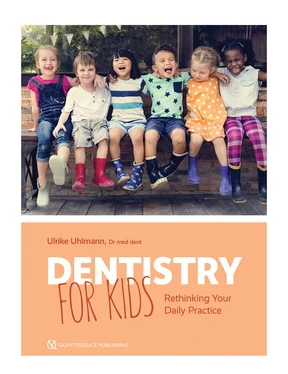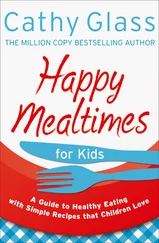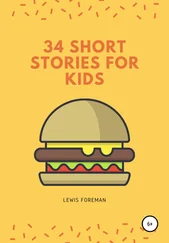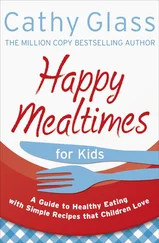Now and then parents are profoundly confused because they get contradictory advice from midwives, pediatricians, dentists, and, last but not least, from the Internet. This is why it is all the more important for the dental team to give consistent advice as the authority responsible for dental health.
Fluorides
Fluorides are the most important pillar of caries prevention. They are safe in the concentrations we use and prescribe, their action has been repeatedly proved scientifically, and in our dental practices we see the positive effects of prophylaxis and treatment with fluorides every day. In the dental practice, the medical history form should include questions about possible sources of fluoride (toothpaste, supplements prescribed by a pediatrician, mouthwashes, fluoride water intake) and the frequency of their use. Parents must be told about the consequences of avoiding fluoridation (increased caries risk) and about the consequences of overdosing (fluorosis).
The American Academy of Pediatrics recommends that fluoridated toothpaste be used for all children starting at tooth eruption. 1Only a smear (the size of a grain of rice) should be used to the age of 3 years, after which a pea-sized amount is appropriate until age 6 (Fig 3-5). These small amounts may reduce the risk of fluorosis, according to the American Academy of Pediatric Dentistry (AAPD). 2The teeth should be brushed twice a day. Furthermore, professionally applied fluoride varnish is recommended every 3 to 6 months starting at tooth emergence.

Fig 3-5 Examples of a smear (a) and pea-sized amount (b) of toothpaste.
Water fluoridation levels are also important. Each city, state, and county all have different levels of fluoride in the water, so it is advisable to contact your state or city water supply to check these levels. If the water is not fluoridated or insufficiently fluoridated, or even if the child simply does not drink it, fluoride supplements are recommended ( Table 3-1). Fluoridated water should be used to mix formula for babies who are bottle-fed. The recommendations for fluoride administration at home and in the dental practice for high-risk children are given in chapter 7.
TABLE 3-1 Dietary fluoride supplementation schedule based on water fluoridation levels
| Age |
< 0.3 ppm F |
0.3–0.6 ppm F |
< 0.6 ppm F |
| Birth to 6 months |
0 |
0 |
0 |
| 6 months to 3 years |
0.25 mg |
0 |
0 |
| 3 to 6 years |
0.5 mg |
0.25 mg |
0 |
| 6 to at least 16 years |
1 mg |
0.5 mg |
0 |
If parents simply want to brush fluoride-free, they must be told about the increased risk of caries. It is indeed a fact that thorough oral hygiene and adequate caries prevention are possible even with fluoride-free toothpaste. As far as the author is concerned, there is no use trying to convince absolute fluoride opponents. However, it should be made absolutely clear that other caries-preventive measures (especially reducing daily sugar intake) must be taken to successfully prevent caries.
Along with careful oral hygiene, reducing sugar consumption is the only really efficient measure in prophylaxis without fluorides. Admittedly, parents easily underestimate what is meant by the term “sugar reduction.” The World Health Organization recommends maximum daily consumption of free sugars of 10% relative to total calorie intake. To achieve caries reduction, a reduction to 5% is probably required; that is equivalent to a total sugar quantity of 15 g for children. 3For comparison, one can of Coke contains approximately 35 g sugar, and one serving of the average breakfast cereal we find on most tables has about 10 g of sugar. These figures can make it clear to parents how difficult it is to reduce the quantities of sugar consumed so sharply that a caries-preventive effect is really noticeable. In other words, caries prophylaxis is possible without fluoride, but it is very difficult for most of the families we treat.
GRINDING TEETH
Many parents will tell you about the grinding sounds coming from their children, primarily at night. Prevalence rates in the literature range from 6% to 50%, which illustrates the inconsistent nature of the studies on this subject. 4Some natural abrasion of the primary teeth is physiologic as part of the dynamic growth and development process and may even be necessary to ensure proper jaw growth and physiologic alignment of the 6-year molars. 5
In extremely rare cares, however, primary teeth exhibit levels of attrition that require treatment. In a review, Restrepo et al wrote that the available literature did not support demands to treat bruxism in children. 6Nevertheless, there are studies that provide evidence of pathologic causes of nocturnal bruxism. In a study from 2009, Serra- Negra et al discovered that children exhibiting certain personality traits (a high degree of responsibility and neuroticism) have a higher rate of nocturnal bruxism. 7DiFrancesco et al reported that children’s nocturnal tooth grinding significantly improved after tonsillectomy and adenoidectomy. 8This shows that nocturnal grinding can also be caused by myofunctional imbalances; the reasons for this can be various (eg, mouth breathing, adenoids, tongue-tie, etc) and must be examined.
If the levels of attrition are extremely high, dentists should carry out myofunctional diagnostics, check for tongue-tie, and, if necessary, consult an ENT (ear, nose, and throat) physician in an interdisciplinary approach to exclude any narrowing of the upper airways. Behavioral therapy measures for older children (stress reduction) are also a possibility. It is important to understand that tooth grinding in the permanent dentition can no longer be classified as a physiologic part of the growth process.
TEETHING
Teething is a common concern for parents because it results in lack of sleep for the whole family as well as various side effects during the developmental stage. While infants are teething, parents often report issues such as red cheeks, raised temperature or fever, diarrhea, tearfulness, increased salivation, nonspecific skin rash, increased cough, and general clinginess or whiny behavior. There are various measures that parents can take to relieve their child’s teething pains and these unpleasant side effects. Parents are often grateful for tips because they lessen their own sense of helplessness in dealing with an overtired, unhappy baby.
As a preventive measure, parents can regularly massage their infant’s gums with special teething gloves and mittens. Because this oral phase begins within the first year of a child’s life, most infants will allow these sorts of manipulations in the mouth without difficulty. These aids ensure that the gingiva is well perfused and, as a positive side effect, babies become accustomed early to oral hygiene rituals they will experience later.
Depending on the child’s age, parent preference, and the severity of the problems, mechanical aids or pain-relieving products can be used to soothe teething infants. Growth spurts are often accompanied by tooth eruption, which makes it difficult to differentiate which area of development is the source of discomfort for the child.
Teething aids
Teething aids such as a chilled teething ring or washcloth can provide relief. When using teething rings, it is important to make sure the products are free of toxins. In tests, a few products have been found to contain phthalates (plasticizers); these certainly have no place inside a child’s mouth. Teething rings do not belong in the freezer because they will become too hard, potentially causing injury to the oral mucosa. Furthermore, freezing makes teething rings porous more quickly. The rings should be cleaned regularly under hot water. When using teething rings, parents should make sure they are not used habitually but in a focused, restrictive way and when required. Otherwise, they can prevent the child from maturing in a myofunctional sense. 5
Читать дальше













